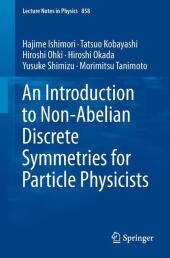 Neuerscheinungen 2012Stand: 2020-01-07 |
Schnellsuche
ISBN/Stichwort/Autor
|
Herderstraße 10
10625 Berlin
Tel.: 030 315 714 16
Fax 030 315 714 14
info@buchspektrum.de |

Hajime Ishimori, Tatsuo Kobayashi, Hiroshi Ohki
(Beteiligte)
An Introduction to Non-Abelian Discrete Symmetries for Particle Physicists
By Hajime Ishimori, Tatsuo Kobayashi, Hiroshi Ohki et al.
2012. 2012. xii, 283 S. 8 SW-Abb. 235 mm
Verlag/Jahr: SPRINGER, BERLIN 2012
ISBN: 3-642-30804-X (364230804X)
Neue ISBN: 978-3-642-30804-8 (9783642308048)
Preis und Lieferzeit: Bitte klicken
This book introduces and explores the group-theoretical aspects of many concrete groups and shows how to derive conjugacy classes, characters, representations, and tensor products for these groups (with a finite number) when algebraic relations are given.
These lecture notes provide a tutorial review of non-Abelian discrete groups and show some applications to issues in physics where discrete symmetries constitute an important principle for model building in particle physics. While Abelian discrete symmetries are often imposed in order to control couplings for particle physics - in particular model building beyond the standard model - non-Abelian discrete symmetries have been applied to understand the three-generation flavor structure in particular.
Indeed, non-Abelian discrete symmetries are considered to be the most attractive choice for the flavor sector: model builders have tried to derive experimental values of quark and lepton masses, and mixing angles by assuming non-Abelian discrete flavor symmetries of quarks and leptons, yet, lepton mixing has already been intensively discussed in this context, as well. The possible origins of the non-Abelian discrete symmetry for flavors is another topic of interest, as they can arise from an underlying theory - e.g. the string theory or compactification via orbifolding - thereby providing a possible bridge between the underlying theory and the corresponding low-energy sector of particle physics.
This text explicitly introduces and studies the group-theoretical aspects of many concrete groups and shows how to derive conjugacy classes, characters, representations, and tensor products for these groups (with a finite number) when algebraic relations are given, thereby enabling readers to apply this to other groups of interest.
Introduction.- Basics of Finite Groups.- Subgroups and Decompositions of Multiplets.- Anomalies.- Non-Abelian Discrete Symmetry in Quark/Lepton Flavor Models.- Useful Theorems.- Representations of S4 in Different Bases.- Representations of A4 in Different Bases.- Representations of A5 in Different Bases.- Representations of T1 in Different Bases.- Other Smaller Groups.- References.
From the reviews:
"This book presents, for the first time, a self-contained and complete practical guide for the use of (non-Abelian) discrete groups in particle physics, and more precisely for current developments in the context of the three-generation flavor models. ... this book constitutes a very valuable handbook for any physicist interested in the role of finite groups in the explicit construction of flavor models, and it will certainly become one of the canonical references for practical use." (Rutwig Campoamor-Stursberg, Mathematical Reviews, June, 2013)


